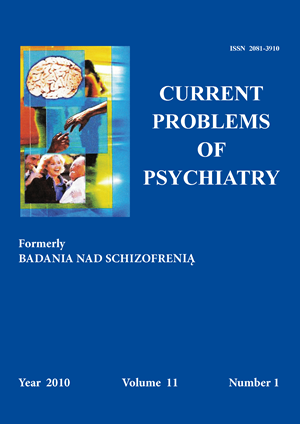Gender and severity of Internet addiction symptomsas shown by lower and upper secondary school students
Słowa kluczowe:
Internet addiction, gender, adolescentsAbstrakt
The aim of the study was to provide an answer to the following research problem: do any differences occur, if any, between girls and boys who attend upper and lower secondary schools and as regards the Internet addiction symptoms measured by the Internet Addiction Test and which symptoms of the Internet addiction do these differences concern?
Examined group: The research covered 518 students (229 boys and 289 girls), out of whom 98 boys and 77 girls attended lower secondary school and 131 boys and 212 girls attended upper secondary school. The total of 251 respondents came from urban areas and 280 from rural areas.
Methods: In the research the Questionnaire by Potembska [13] and the Internet Addiction test designed by Young [1] were used.
Results:The results of the statistical analyses carried out show statistically significant differences between the boys and girls attending lower and upper secondary schools within the Internet Addiction test by Young.
Conclusions:
- Compared to the girls, the boys are characterised by a greater severity of the Internet addiction.
- Statistically significant differences were found between the boys and girls attending upper secondary school within a larger number of Internet addiction symptoms measured by the Internet Addiction test as compared to the boys and girls attending lower secondary school.
Bibliografia
1. Young K.S. Caught in the net. New York: John Wiley & Sons; 1998.
2. Shapira N.A., Lessig M.C., Goldsmith T.D., Szabo S.T., Lazoritz M., Gold M.S., Stein D.J. Problematic internet use: proposed classification and diagnostic criteria. Depress. Anxiety, 2003; 17(4): 207-216.
3. Beard K.W., Wolf E.M. Modification in the proposed diagnostic criteria for internet addiction. Cyberpsychol. Behav., 2001; 4: 377-383.
4. Siomos K.E., Dafouli E.D., Braimiotis D.A., Mouzas O.D., Angelopoulos N.V. Internet addiction among Greek adolescent students. Cyberpsychol. Behav., 2008; 11(6): 653-657.
5. Korea National Statistics. Korean Statistics Yearbook. Seoul, Korea: Korean National Statistics; 2005.
6. Lam L.T., Peng Z.W., Mai J.C., Jing J. Factors associated with Internet addiction among adolescents. Cyberpsychol. Behav., 2009;12: 551-555.
7. Ko C.H., Yen J.Y., Chen C.C., Yen C.F. Gender differences and related factors affecting online gaming addiction among Taiwanese adolescents. J. Nerv. Ment. Dis., 2005; 193: 273-277.
8. Ko C.H., Yen J.Y., Yen C.F., Chen C.S., Wang S.Y. The association between Internet addiction and belief of frustration intolerance: the gender difference. Cyberpsychol. Behav., 2008; 11(3): 273-278.
9. Kaltiala-Heino R., Lintonen T., Rimpelä A. Internet addiction? Potentially problematic use of the Internet in a population of 12-18 year-old adolescents. Addict. Res. Theory, 2004; 12: 89-96.
10. Johansson A., Gotestam K. Internet addiction: characteristics of a questionnaire and prevalence in Norwegian youth (12-18 years). Scand. J. Psych., 2004; 45: 223-229.
11. Yang C.K. Sociopsychiatric characteristics of adolescents who use computers to excess. Acta Psychiatr. Scand., 2001; 104: 217-222.
12. Weiser E.B. Gender Differences in Internet Use Patterns and Internet Application Preferences: A Two-Sample Comparison. Cyberpsychol. Behav., 2000; 3: 167-178.
13. Pawłowska B., Potembska E. Właściwości psychometryczne Kwestionariusza do Badania Uzależnienia od Internetu (KBUI). Badania nad Schizofrenią, 2009; X, 10: 310-321.


